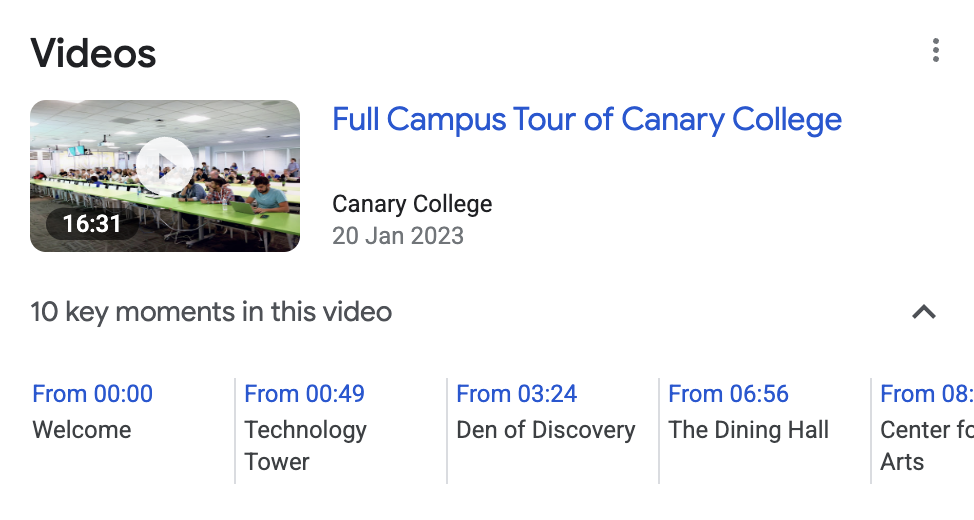Vimeo 如何改善客戶的影片搜尋引擎最佳化
發布日期:2023 年 1 月 25 日
Vimeo 簡介
Vimeo 是全方位的影片解決方案,每天都有超過 2.6 億名使用者,新增 35 萬部新影片,目標是為所有人提供專業品質的影片。
挑戰
Vimeo 的客戶需要獨立實作及管理影片搜尋引擎最佳化 (SEO) 的最佳做法,包括在自家網站中新增結構化資料、提交 Sitemap、呼叫 Indexing API 等,而且這些知識都相當專業,難以擴充。此外,Vimeo 的章節功能 (按時間標記標示的影片片段) 並未啟用,因此無法顯示在 Google 搜尋結果中。
2022 年,Vimeo 採用 Google 最佳做法來解決這些難題,當中包含導入 VideoObject 結構化資料,並為影片播放器套用最佳做法,藉此讓 Vimeo 客戶不需要執行額外作業,就能享有重要時刻等功能帶來的好處。
允許大規模建立影片索引
為了將索引功能最佳化,並讓內嵌影片盡可能出現在相關搜尋結果中,Vimeo 採用了 Google 針對使用 iframe 嵌入的影片播放器提供的新指引。搭配 noindex 使用的新 indexifembedded 規則,可透過內嵌將標記歸因。套用了這個 VideoObject 標記後,嵌入客戶網頁上的 Vimeo 影片就有資格編入索引,而客戶不必自行加入標記。這項變更會套用至 Vimeo 目前影片庫中超過 7.5 億部的嵌入影片,以及日後新增和嵌入的所有影片。
如果您是像 Vimeo 這類嵌入式影片播放器的開發人員,也可以協助您的客戶享有影片搜尋的好處,並改善在 Google 搜尋中的顯示方式。您只需要完成以下操作即可:
- 將
VideoObject結構化資料新增到每個來源播放器網頁 (即代管該播放器的網頁,使用者會在網頁中其他地方嵌入iframe)。 - 在
embedUrl資源所指向的網頁上,除了 robotsnoindex規則之外,再新增indexifembedded規則,這樣一來,只有嵌入到客戶網頁的影片能夠編入 Google 搜尋索引中:<meta name="robots" content="noindex, indexifembedded" />
- 等待 Googlebot 重新檢索受影響的網頁。
運用結構化資料啟用重要時刻功能
當 Google 搜尋顯示重要時刻時,系統會進一步強化影片複合式搜尋結果,附上可展開且可捲動的時間列 (含有加上標籤的區隔)。
「Vimeo 的其中一項目標,是要盡可能讓影片發揮最佳效果,而協助使用者不必具備工程師或搜尋引擎最佳化專家技能,就能擴大觸及範圍和曝光率,是我們達成此目標的一環。將影片內容中的知識展現出來是我們的重點之一,而「重要時刻」功能讓這個目標能直接在客戶的搜尋結果網頁中實現,強化他們的影片價值。- Vimeo 產品資深資深總監 Alex Cherny
為了讓所有 Vimeo 章節都能顯示為 Google 搜尋的「重要時刻」,Vimeo 已在所有影片代管網頁中加入 Clip 標記。此外,Vimeo 也導入了 Seek 標記,因此,如果影片沒有 Vimeo 章節,Google 還是能自動識別重要時刻。

搜尋者點選其中任一區隔,就會前往該 Vimeo 嵌入式影片所在的創作者網頁,影片會從時間標記所選的位置開始播放。如果您是像 Vimeo 這類嵌入式影片播放器的開發人員,也可以啟用重要時刻功能。
如果要針對 iframe 嵌入功能實作「重要時刻」,您需要為 iframe 嵌入功能開發一個方法,將開始時間參數傳達給來源影片播放器。舉例來說,您可以使用 postMessage JavaScript 包裝函式來啟用這項通訊功能。JavaScript 嵌入不需要使用這類包裝函式,因為系統可以在相同的網址網頁管理播放器控制項。
